
The Feast of Corpus Christi, also known as the Solemnity of the Most Holy Body and Blood of Christ, is a Christian liturgical solemnity celebrating the Real Presence of the Body and Blood, Soul and Divinity of Jesus in the elements of the Eucharist; it is observed by the Latin Church, in addition to certain Western Orthodox, Lutheran, and Anglican churches. Two months earlier, the institution of the Eucharist at the Last Supper is observed on Maundy Thursday in a sombre atmosphere leading to Good Friday. The liturgy on that day also commemorates Christ's washing of the disciples' feet, the institution of the priesthood, and the agony in the Garden of Gethsemane.

The Grote Kerk or St.-Bavokerk is a Reformed Protestant church and former Catholic cathedral located on the central market square in the Dutch city of Haarlem. Another Haarlem church called the Cathedral of Saint Bavo now serves as the main cathedral for the Roman Catholic Diocese of Haarlem-Amsterdam.

Eucharistic adoration is a Eucharistic devotional practice primarily in Western Catholicism, but also to a lesser extent in certain Lutheran and Anglican traditions, in which the Blessed Sacrament is adored by the faithful. This practice may occur either when the Eucharist is exposed, or when it is not publicly viewable because it is reserved in a place such as a church tabernacle.
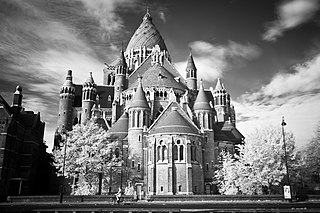
The Cathedral of Saint Bavo is a cathedral in Haarlem, the Netherlands, built by Joseph Cuypers from 1895 to 1930 to replace the former waterstaatskerk in the Jansstraat called the St. Joseph. That church was itself a replacement for the Sint-Bavokerk, that had been converted to Protestantism from Catholicism in 1578. The Cathedral of Saint Bavo now serves as the main cathedral for the Roman Catholic Diocese of Haarlem-Amsterdam. Within the cathedral, the former sacristy has been converted into a small museum (schatkamer) containing historical artefacts from Haarlem's Catholic past.
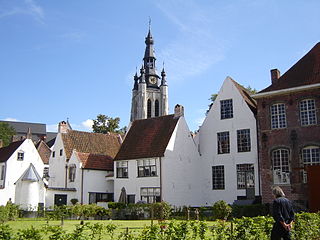
A beguinage, from the French term béguinage, is an architectural complex which was created to house beguines: lay religious women who lived in community without taking vows or retiring from the world.

The Beguines and the Beghards were Christian lay religious orders that were active in Western Europe, particularly in the Low Countries, in the 13th–16th centuries. Their members lived in semi-monastic communities but did not take formal religious vows; although they promised not to marry "as long as they lived as Beguines," to quote one of the early Rules, they were free to leave at any time. Beguines were part of a larger spiritual revival movement of the 13th century that stressed imitation of Jesus' life through voluntary poverty, care of the poor and sick, and religious devotion.
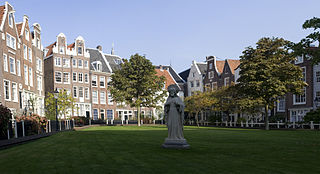
The Begijnhof is one of the oldest hofjes in Amsterdam, Netherlands. A group of historic buildings, mostly private dwellings, centre on it. As the name suggests, it was originally a béguinage. Today it is also the site of two churches, the Catholic Houten Huys and the English Reformed Church.

The Holy Corner or Old Saint Elisabeth is a beguinage in Ghent, Belgium. It is one of three beguinages in the city – the other two are the new Saint Elisabeth beguinage in the suburb of Sint-Amandsberg and Our Lady Ter Hooyen in the Lange Violettenstraat. Both Saint Elisabeth beguinages were named after Elisabeth of Hungary, also known as Saint Elisabeth of Thuringia.

The Cathedral Church of St Mary and St Thomas is a Roman Catholic cathedral in Northampton, England. It is the seat of the Bishop of Northampton and mother church of the Diocese of Northampton which covers the counties of Northamptonshire, Bedfordshire, Buckinghamshire and part of Berkshire north of the River Thames. The cathedral is situated in the north of the town, along the Barrack Road.
The Tabernacle Societies were lay Eucharistic Adorative associations within Roman Catholic parishes, principally in America and Australia, forming part of the Archassociation of the Eucharist under the guidance of the Association of Perpetual Adoration of the Blessed Sacrament.

Nieuwezijds Kapel, or Heilige Stede or Chapel of the Heilige Stede refers to a site in Amsterdam that includes shops and a Dutch Reformed church built in 1908 on the site of a church once called the Heilige Stede, originally built in the 15th century to replace a chapel that burned in a city fire of 1452. That original chapel had been built in 1347 as a result of the miracle of Amsterdam, located on the Kalverstraat where this miracle with the eucharistic host occurred.

The Groot Begijnhof of Leuven is a well preserved beguinage and completely restored historical quarter containing a dozen streets in the south of downtown Leuven. About 3 hectares in size, with some 300 apartments in almost 100 houses, it is one of the largest remaining beguinages in the Low Countries. It stretches on both sides of the river Dijle, which splits into two canals inside the beguinage, thus forming an island. Three bridges connect the parts of the beguinage. The complete beguinage is owned by the University of Leuven and used as a campus, especially for housing academics.
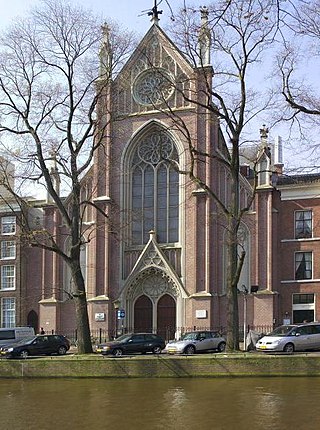
Onze Lieve Vrouwekerk (Syriac: ܥܕܬܐ ܕܝܠܕܬ ܐܠܗܐ, Ito dyoldath Aloho) is a Syriac Orthodox church in the centre of Amsterdam. The church is used both by the Syriac Orthodox community and the Roman Catholic of Opus Dei. Emphasis is placed on the hearing of confessions and of choral liturgy. The building has the Dutch status of a Rijksmonument.
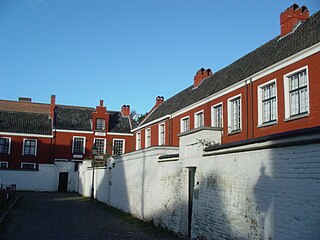
The small beguinage O.L.V. Ter Hooyen is situated in southern area of Ghent. This beguinage was built on the ‘Groene Hooie’, between the ‘Hooipoort’ and the ‘Vijfwindgatenpoort’. That is how this little beguinage got its name.

The Church of St. John the Baptist at the Béguinage is a Roman Catholic parish church in central Brussels, Belgium. It is dedicated to Saint John the Baptist.
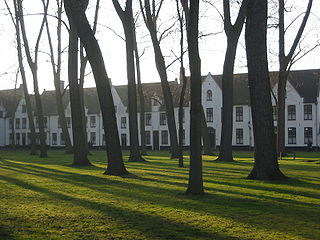
The Princely Beguinage Ten Wijngaerde is the only preserved beguinage in the Belgian city of Bruges. There are no more Beguines living there, but since 1927 it has functioned as a convent for Benedictines, founded by canon Hoornaert. In the same year the houses at the west side were also reshaped and enlarged into the Monasterium De Wijngaard, a priory of Benedictine nuns.

The Begijnhof, Utrecht, was a beguinage in the Dutch city of Utrecht.
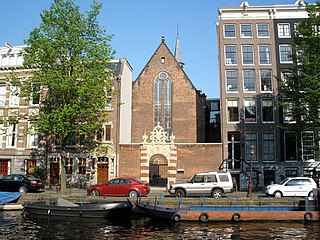
The Agnietenkapel is a 15th-century Gothic chapel in Amsterdam. It is the birthplace of the University of Amsterdam and still in use for doctoral dissertations and other university ceremonies, as well as academic events such as lectures and symposiums. The building has held rijksmonument status since 1970.
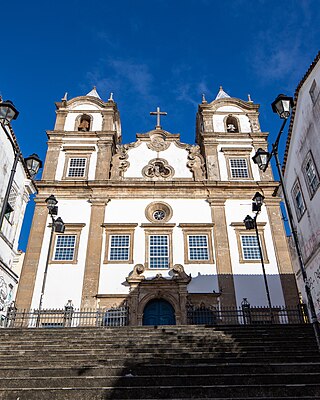
The Church of the Blessed Sacrament at Rua do Passo is an 18th-century Roman Catholic church in Salvador, Bahia, Brazil. It is dedicated to the Blessed Sacrament. The Church of the Blessed Sacrament at Rua do Passo was listed as a historic structure by National Institute of Historic and Artistic Heritage (IPHAN) in 1938 and is part of the Historic Center of Salvador UNESCO World Heritage Site.
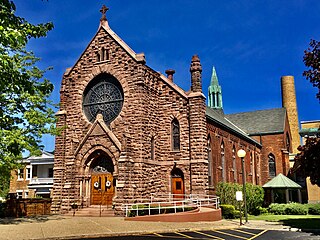
Blessed Sacrament Church is a historic Roman Catholic church in Buffalo, New York, United States. Constructed in the late 19th century, it remains the home of an active congregation and has been recognized as a historically significant building in the Linwood Historic District of Buffalo.























